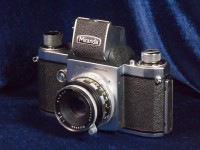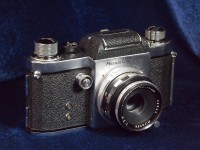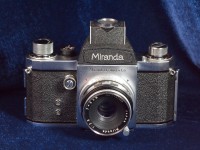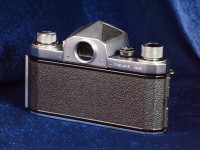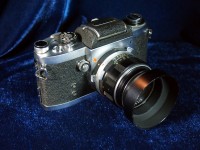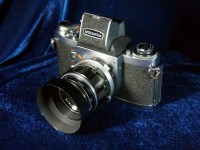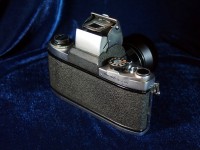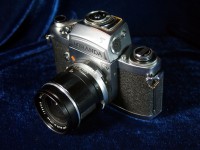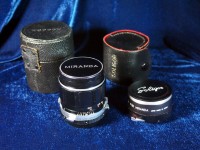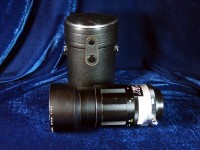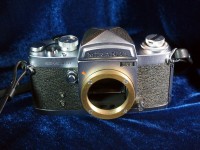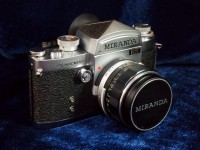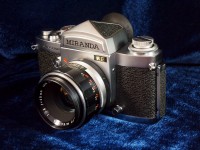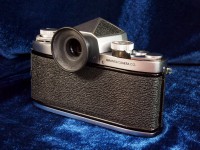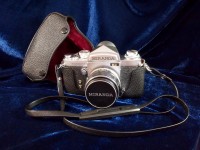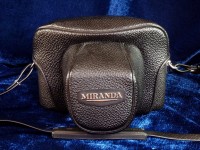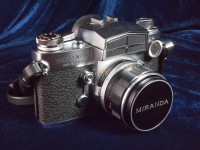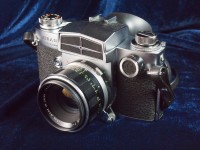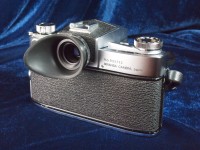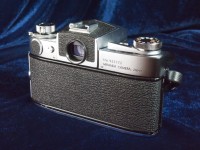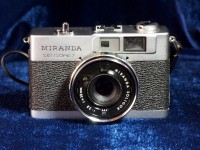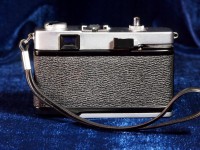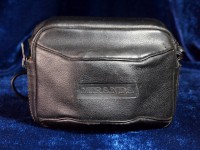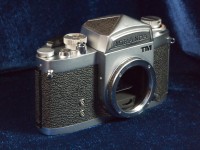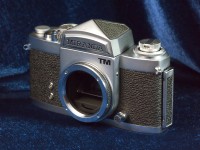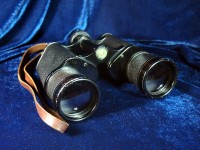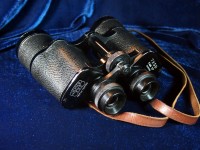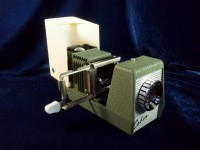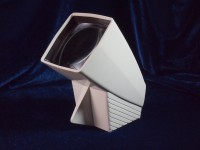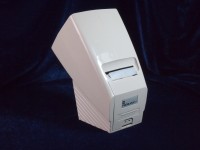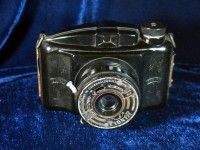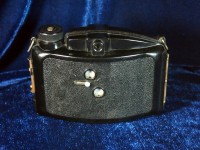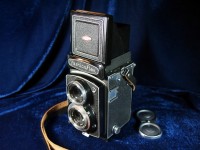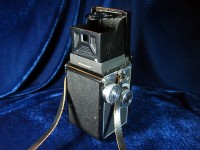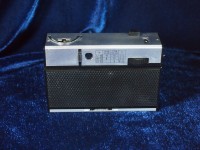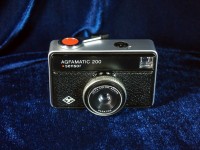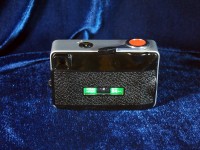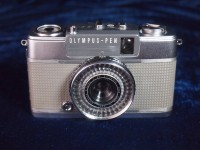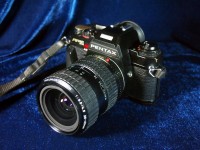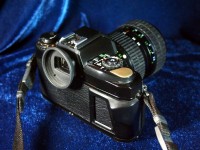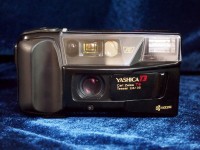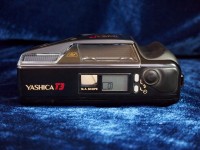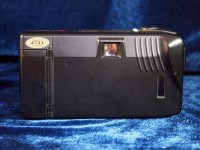This is my collection of old optical devices – binoculars & cameras. Most of them have been used at some point of time by my relatives or friends, or by myself. All the pictures are taken with Olympus PEN E-PL3.
Miranda S
Miranda S (production year 1959, serial number 592277) was an economy version of the original 50’s Orion/Miranda T. It has only the fast speeds from 1/30 to 1/500, and B, and the mirror does not return automatically. To keep the price down the waist level finder VF-1 was fitted as standard. It was also the last knob wind version (Laborecs excluded) produced by Miranda, the first lever wind version A being introduced already in 1958. The lens is a Soligor-made screw-mount 50mm f/2.8, serial number T147205.
This example was found in the UK, looks beautiful, and is in perfect working order.
Miranda Fv / FvT
For technical and other information about Miranda Fv please see a separate page in here.
This is the pride of my camera collection, a Miranda Fv (serial number 713061) bought by my father as new in 1967 or so. For some reason he opted for the then-optional VF-1 waist-level viewfinder.
I have later acquired the pictured metered TTL prism of model FvT (or GT), and the 135mm f/2.8 and 28mm f/2.8 lenses and a Soligor 2x tele-converter.
Miranda Sensomat RE
This is a weird one: I got this 1971 Sensomat RE (serial number 6857640) wreck at a very nominal price from a local second-hand camera shop ‘Kameratori‘. The film advance lever does not work, and everything else seems to be more or less stuck. What makes this interesting is the user-made m42 conversion; some previous owner had removed the original Miranda bayonet (And before anyone asks, no, this is not a TM model!), and replaced it with a somewhat crude homemade m42 (i.e. Pentax) screw mount made from brass.
Miranda Sensomat RE
Here’s another Sensomat RE (serial number 6828896) I bought as ‘slightly faulty’: the built-in exposure meter was supposedly dead and the aperture blades on the Auto Miranda 50mm f/1.8 lens were sticking; both defects are now repaired. It’s a very attractive looking and clean camera, with some extras: a case in perfect condition, a rare rubber eyepiece, and an additional shutter release on top (not fitted in the pictures; I felt that it’s presence made the shutter speed selector difficult to use. I definitely prefer the front-mounted shutter release…)
Miranda Sensorex C
The Miranda Sensorex model was produced between 1967 and 1972. One of the main distinguishing feature is the external diaphragm coupling to the match needle TTL CdS exposure meter, providing metering at full aperture. At the time it was an upmarket feature, only Minolta SRT101 and Nikkormat providing similar functionality. Other notable features are microprism rangefinder, self-timer, film wound indicator and self-zeroing film counter. There were several available viewfinder models (VF1 and VF3), but they weren’t interchangeable with other Mirandas, other than the Automex range.
This is a ‘Sensorex C’ model, serial number 933772, which makes it one of the last production version. It was sourced from the U.S. via eBay, and is in full working order. I have already taken a roll of black-and-white film with it.
Miranda Sensoret
The Sensoret was the only rangefinder-type camera produced by Miranda in 1972. It was a compact, snapshot type camera with a fixed lens and fully programmed exposure automation, good quality 4 element 38mm f/2.8 Tessar type lens and a coupled rangefinder. The shutter was the new SEIKO ESF electronic shutter which controlled the speed and diaphragm settings simultaneously in a combined unit.
The example here (serial number 2446982) is currently for-show-only. The shutter unit seems to be jammed. Even when the camera is loaded with correct 640-type batteries it refuses to work, the shutter blades just move fractionally.
Miranda TM
Miranda TM was based on Sensomat RE, but had a m42 (Pentax/Praktica) screw-mount instead of the standard Miranda dual-mount, and the shutter release was moved from the usual front-mounted Miranda style to the top of the body. It was released in 1974, and was sold also as ‘Soligor TM’ and ‘Pallas TM’. The timing of the release was a bit unfortunate, because Pentax itself abandoned the already-obsolete m42 mount in the following year, introducing the PK bayonet mount. Consequently, TM was not a big success.
This body-only (serial number 4613270) was found in Germany. On slower-than-1/60 speeds the mirror sticks up (a common problem with worn-out Sensomats), otherwise it is working.
Lichter K.O.C. 7×50
These binoculars belonged to my father. They were made in the occupied Japan sometime between 1945-1952. The Lichter company was established to produce optical equipment for the needs of US troops situated in Japan, and when the occupation ended, the company was merged with the other optical companies.
Until recently I was under impression that these were owned by my late grandfather, but my father said that he bought them around ’57 or earlier from Instrumentarium (a big optics store still existing today). It is actually a small miracle that these binoculars have survived more or less intact. As a boy I had a habit of climbing up and around the shore rocks at our summer cottage, watching birds and neighbours with these Dad’s heavy binoculars… Well, I was a careful child. The peculiar smell of the grease used to lubricate the joints still reminds me of the childhood summers…
Erno Cabin 5×5
Cabin 5×5, also sold as ‘Accura Portable Projector’ or ‘Accura Mini’, is a 60’s travel / portable slide projector for 35mm and 5×5 slides, manufactured by ERNO Photo AG of Switzerland , with an Ernolux 75mm f/2.5 lens and a lamp of 220v / 100W.
This is the older of Dad’s two slide projectors, on a more or less permanent ‘loan’ to me. It is in perfect working order.
GAF Pana-Vue 1
GAF Pana-Vue 1 is a simple battery-operated 5×5 slide viewer, originally made in Belgium since the early 70’s, and still available today. It uses two size C batteries.
This beige example has been in the family for as long as I can remember…
DUFA Pionýr
The Pionýr is a Czech copy of the French bakelite camera Boyer Photax, made by DUFA, with exposure formats of 6×6 and 4.5×6 using type 120 film. It was made around 1948 or so. Some sources claim that the shutter has three speeds, 1/25, 1/100 and B, but at least this example has only two, B (bulb) and some undefined speed, 1/25 seems about right. Two aperture stops are provided, f/8 and f/11.
This example was just barely rescued from the fire which burned down my grandparents’ home in the late 60’s. It still has some remains of partially melted film inside. The metal parts are a bit rusty, but otherwise it seems to be in at least marginally usable condition. I dismantled and cleaned the lens/shutter system; a very simple task because everything is held together just by two screws. The lenses are very clean, but the incredibly crude leaf shutter still jams occasionally.
Yashicaflex C
Yashicaflex is a TLR (Twin Lens Reflex) camera brand made by Yashica and manufactured between 1953-1959. It uses 120 film for producing 6x6cm frames. The pictured model C is from year 1955, and the picture taking lens is a Yashikor 80mm f/3.5, while the viewing lens is a Tri-Lausar 80mm f/3.5. The shutter is a Copal unit with speeds B, 1-1/300 and self-timer.
This particular example was owned by my father. According to his recollection he bought it from a now-defunct photography store in Kyttälänkatu, Tampere (name unknown). The shutter is a bit sticky (probably just in need of a good cleanup), so the shutter speeds are all over the place, but otherwise it is in excellent condition.
Agfa ISO-RAPID 1F
This is the second most sold camera model in Finland. The model was manufactured between 1965-1970, and it used Agfa’s RAPID 24×24 film cartridges. The Isinar f8 lens has three apertures and a two-speed shutter.
In 1965 the Coca-Cola Company arranged a campaign in Finland, where you could get this camera by collecting 20 Coca-Cola bottle caps and paying 16 Finnish marks; that’s why these cameras are called ‘Coca-Cola Cameras’ here. That is also the way my mother acquired this camera; it is her first camera. It is said that this camera transformed the art of photography from a specialist hobby to a hobby for masses, at least here in Finland.
Agfa AGFAMATIC 200 Sensor
This is a simple Agfa-made camera using 126-type film cassette, producing 28x28mm frames, so the camera doesn’t need to be turned for landscape- or portrait-shots. It was made from 1972 on, and has four exposure settings, a soft-touch ‘Sensor’ shutter release button, a 1/4″ tripod mount and a Magicube flash socket; a red warning appears in the finder when a used Magicube is in place. The lens is 44mm 3-element f/8.2.
This example is the first camera I have used. It still has a film inside, untouched by some 20 years! I wonder whether I could still have it developed somewhere…
Olympus PEN EE-2
The Olympus PEN was introduced in 1959 and was the first half-frame camera produced in Japan. It was one of the smallest cameras to use 35mm film in regular 135 cassettes. The model EE-2 was produced from 1968 to 1977, and has fully automatic exposure, fixed focusing, hot shoe for flash and a 28mm f/3.5 lens. The transparent window around the lens is for the selenium exposure meter.
I found this little marvel at a camera collector’s sale. It is in full working order, although the paint is a bit scratched.
Pentax Program A
Asahi Pentax introduced this manual-focus, automatic-exposure 35mm SLR in 1984. It has four exposure modes: programmed automatic exposure, aperture-priority, metered manual exposure and programmed flash.
My father bought this to replace the ageing Miranda. It has a Takumar-A 28-80mm f/3.5-4.5 zoom lens.
Yashica T3
Introduced in 1988, the T3 (which is also known as ‘Kyocera T Scope’) by Kyocera is a 35mm film compact camera with a high quality Carl Zeiss T* Tessar f/2.8 35mm lens and a waist-level finder (called ‘N.A.Scope’, or New Angle Scope) on the top of the body. It has auto-focus and auto-exposure systems, and an integrated flash.
This was my faithful photographic workhorse for many years. The picture quality is really excellent for such a small lens, but the auto-focus, which has a tendency to focus to infinity if you give it a slightest chance to do so, ruined lots of closeup photos…

